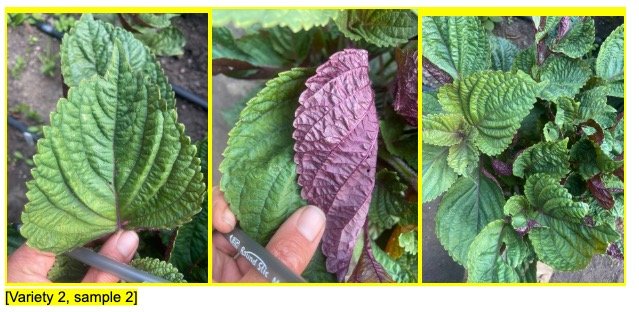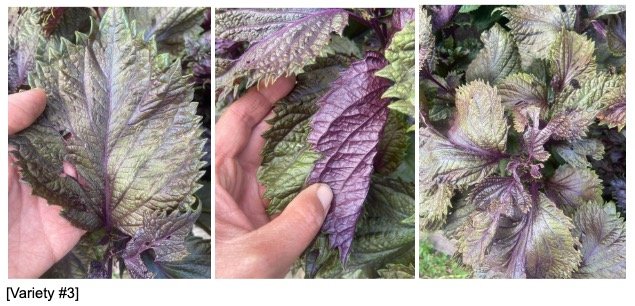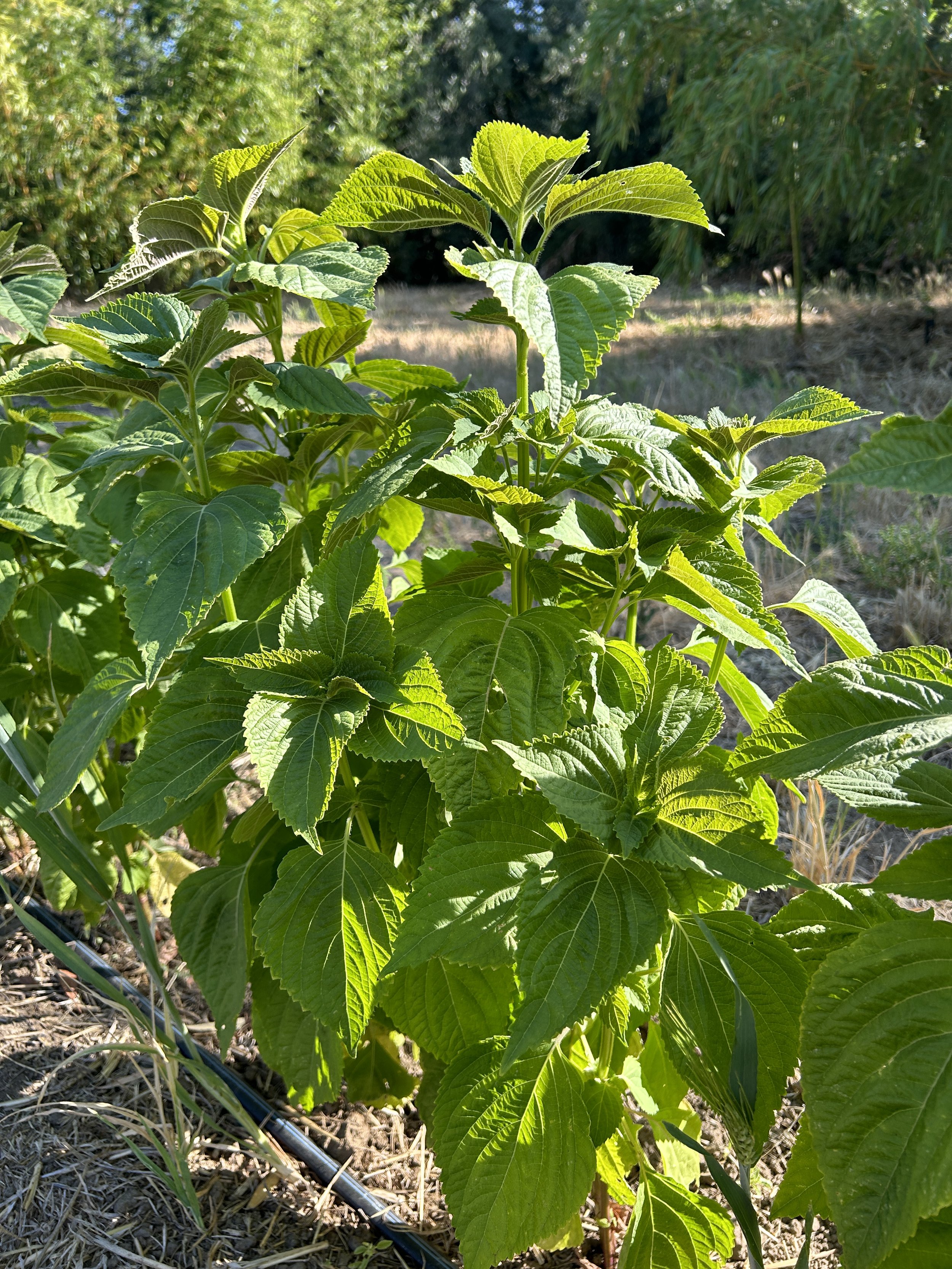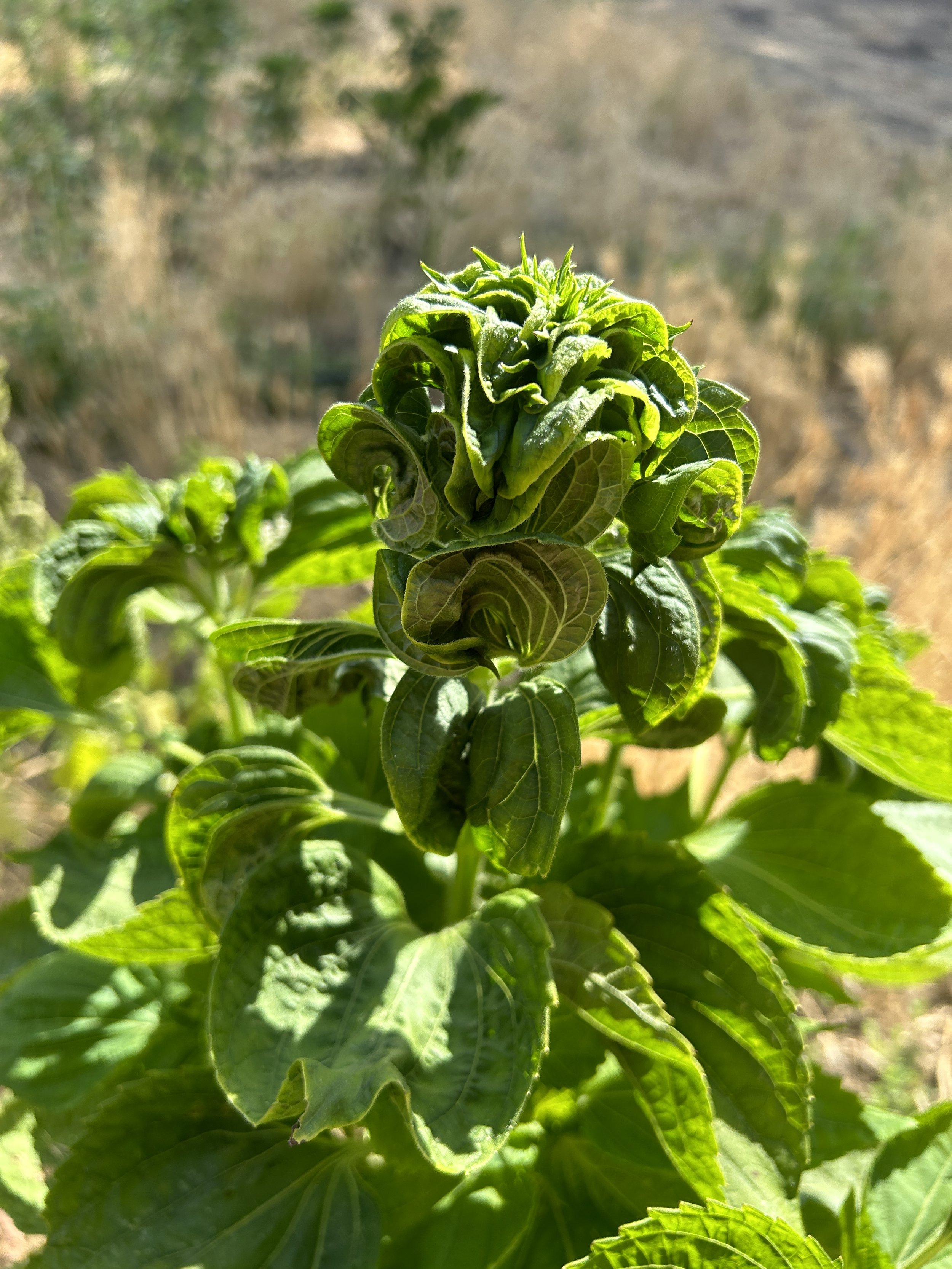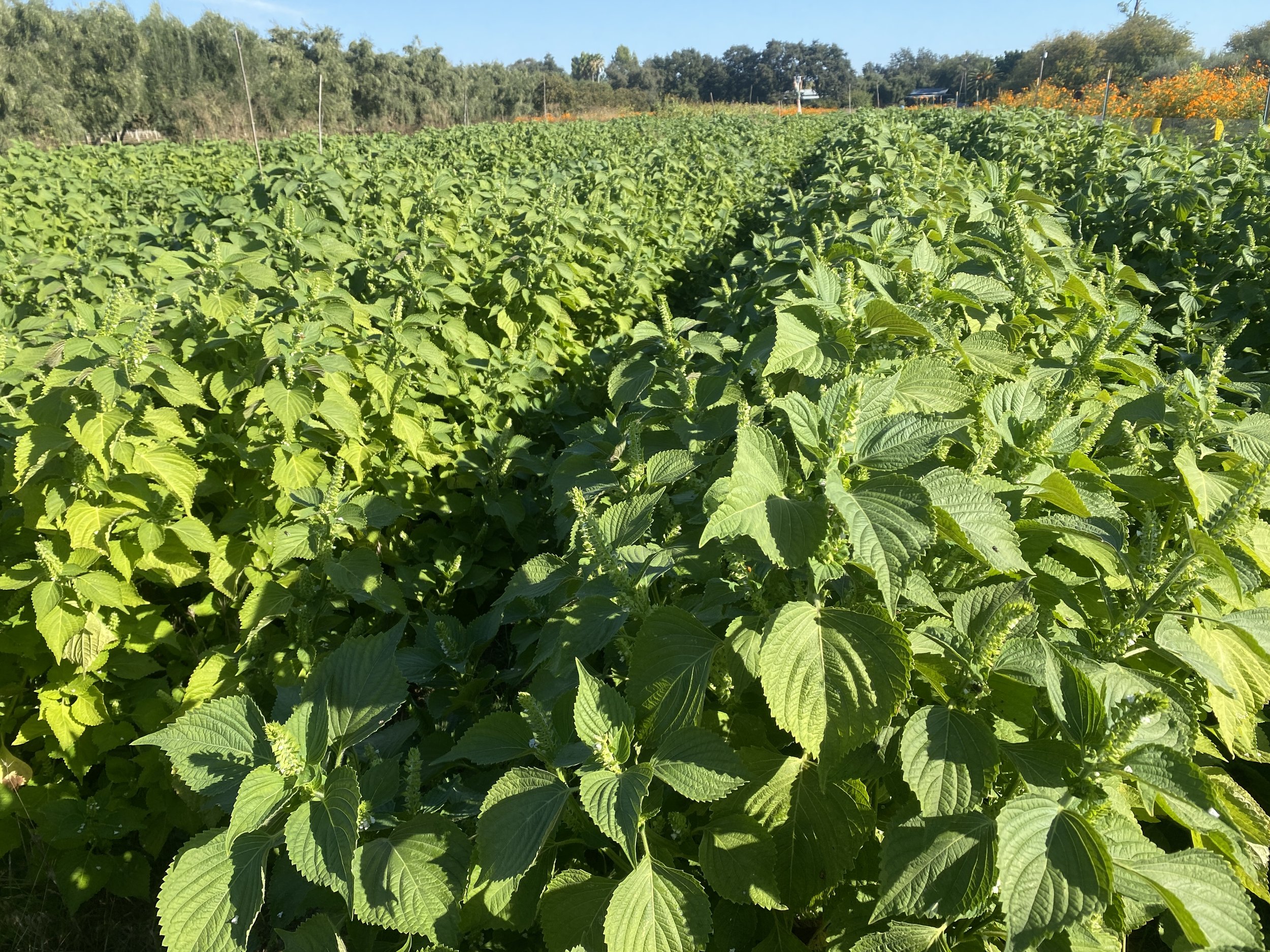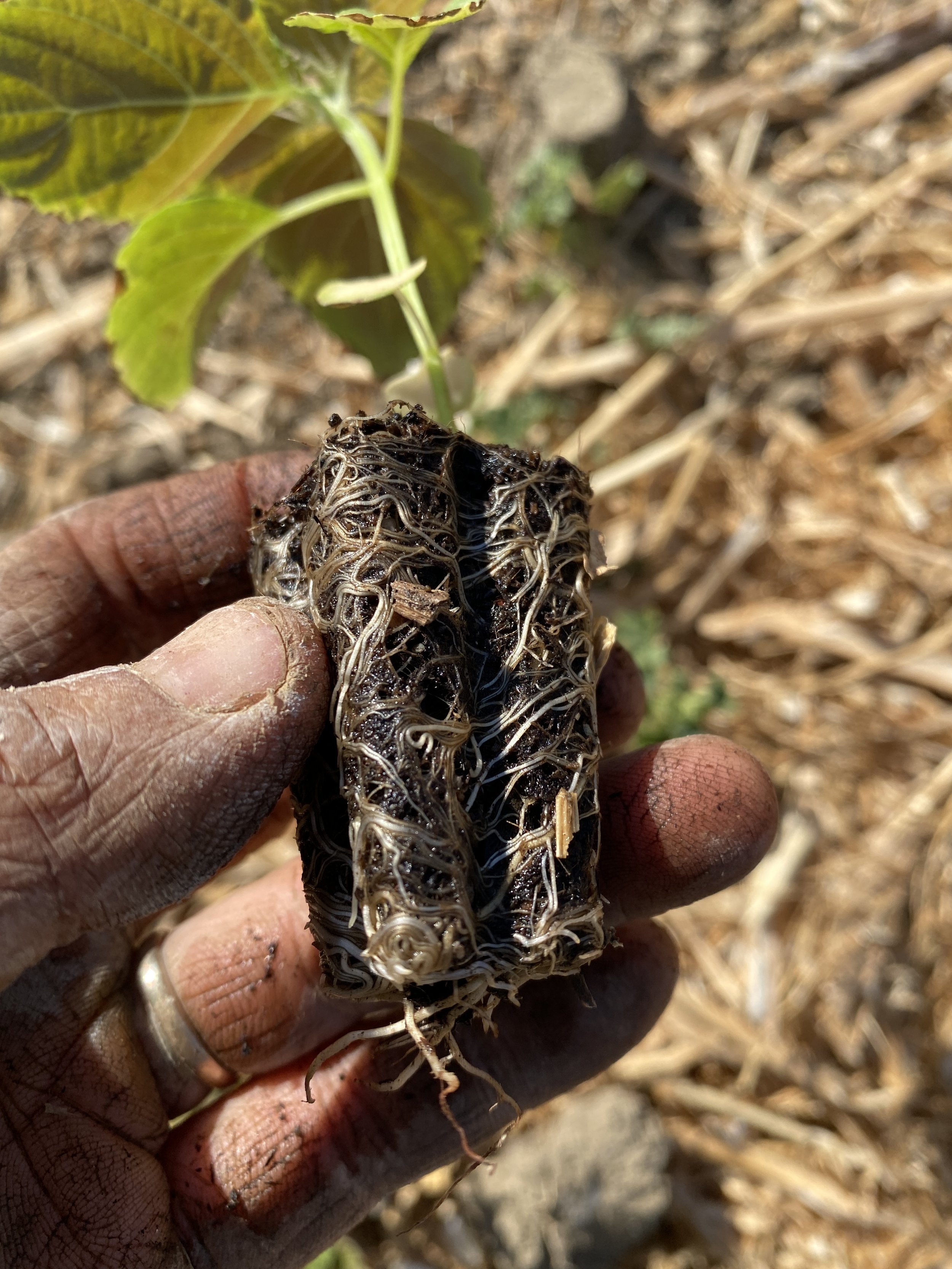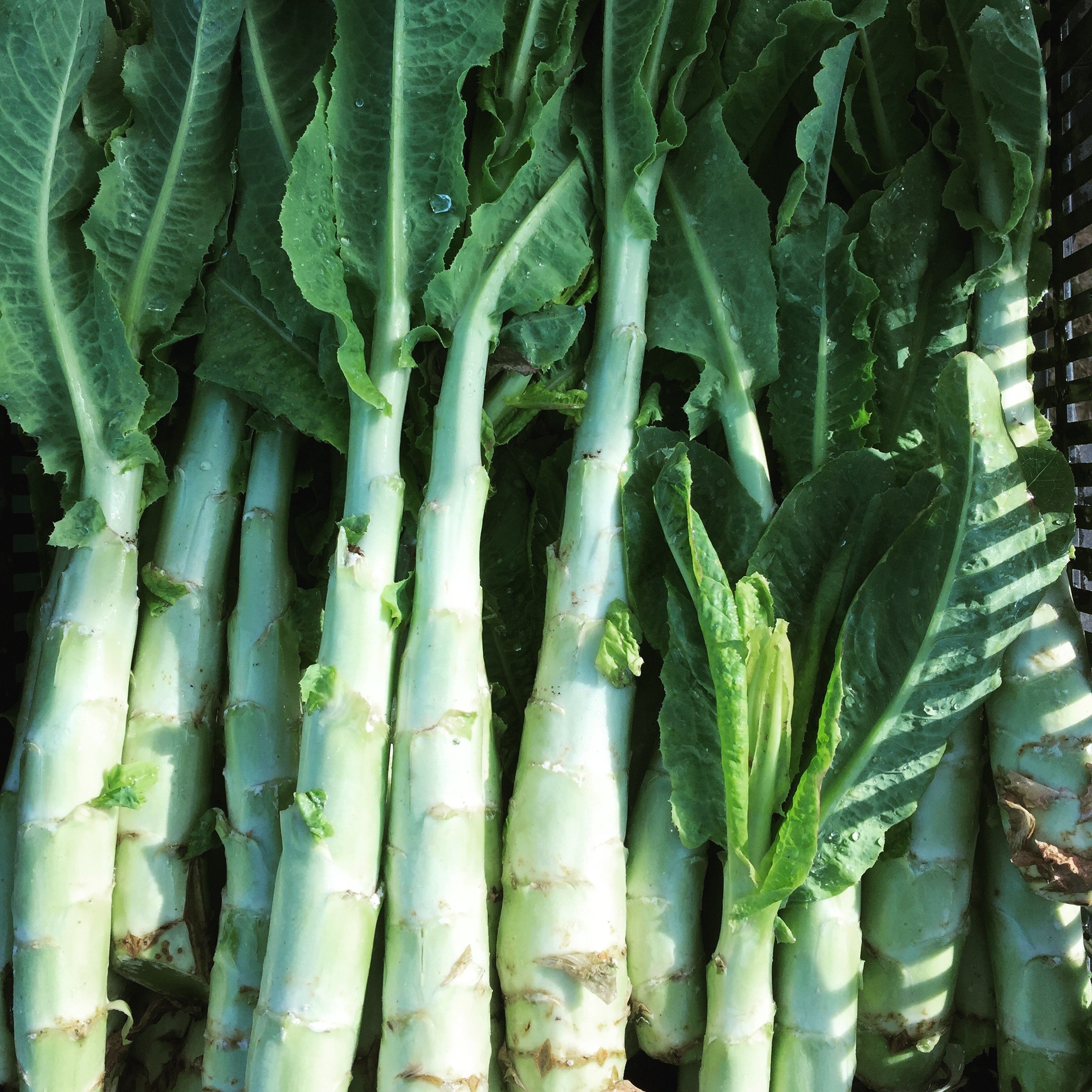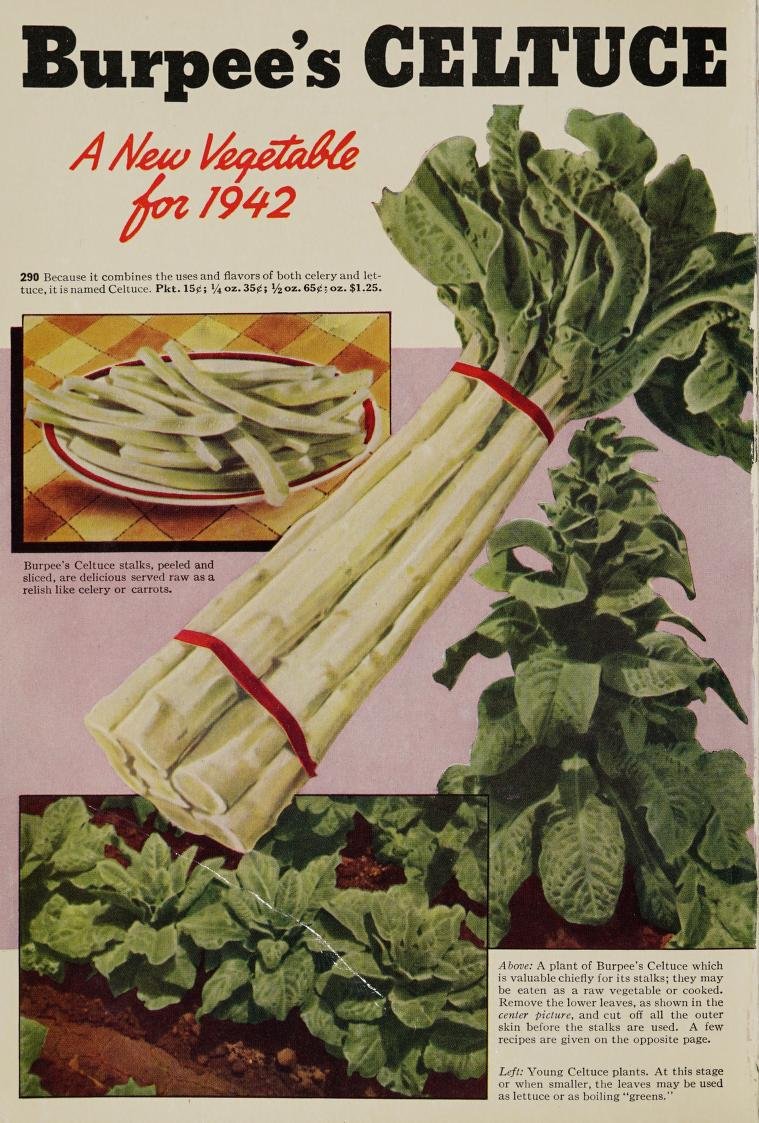Viet Perilla Variety Trials
Kellee Matsushita-Tseng
As we walk beside rows of sunflowers on the edge of the trial area, the shimmering green purple leaves of our Tiá Tô greet us. Though gophers have been a major struggle this year, and beginning with small populations of plants has made this season stressful, we are still excited to share Tiá Tô with community samples from our trials of several varieties of Tiá Tô with the community this year.
This perilla is distinctly different from kkaennip (Korean Perilla) or shiso (Japanese perilla). Some of the things that we are wanting to explore this year is what feels most distinctly important for Tiá Tô, what are the qualities that make it distinct and beloved for folks that love it. While Tiá Tô can be found readily at Vietnamese markets in urban centers, it is less readily available for folks outside of cities with large Vietnamese communities. Chef Amanda of Auntie Manna’s has described Tiá Tô as something “between mint and cilantro”, that is “vibrant and sometimes gives a citrus hint when eaten fresh'', with leaves that are smaller than most Korean or Japanese perilla types. Tiá Tô that is found in the Vietnamese market is typically purple on one side and green on the other side, with leaves that are tightly and uniformly serrated. The purple of these leaves is much darker and more vibrant than the subtle lavender undersides of the 38N Kkaennip that is offered by Second Generation Seeds, for instance.
In this trial of Tiá Tô, our goal is to see what the most important traits are to retain, keep clear, and steward, and to gather more information about the most important aspects of Vietnamese perilla. Within the Viet community locally, it seems as though Tiá Tô is often commonly accessed through either small home gardens with vegetables and herbs, or even from cuttings obtained from the market. This year we are trialing 4 varieties of Tiá Tô from seed to understand a little bit more about the taste, color, and varietal preferences of the Vietnamese community.
Side by side seedling differences
We have definitely seen some genetic variation seed batches from the same source, showing either difference in color (that amount of red/purple pigmentation), or the leaf/serration pattern, or the frilliness and overal leaf shape. We are growing Tiá Tô from a Vietnamese elder in the San Jose community, and some from three other small seed companies (Tomorrow Seeds, Caribbean Seeds, and True Love Seeds). With challenges in access to growing space and greenhouse space, our trials began later than ideal. Seedlings were planted into the ground on June 17, with a somewhat late start to a plant that flowers in response to photoperiod length.
Staging seedlings for planting in a semi-randomized fashion
Planting map-original
Planting map after replants in yellow, and gopher losses in red
Nonetheless, our plants have rapidly put on leaf sets over the past two months thanks to fertile and well prepared soil. We attempted to plant in a somewhat randomized pattern to get more accurate trial results, though gopher less has made it hard to assess the success of using a randomized pattern to balance variability in the field. Below are photos from the 4 varieties that we are growing this year, as well as additional photos showing some of the genetic variation expressed within a single variety (shown when there are two samples of the same variety below)
While Vietnamese communities in diaspora are of course existing with their creative resilience and resourcefulness to create the flavors of home wherever folks are, it’s definitely undeniable that the flavors and qualities of Tiá Tô are distinct and beloved, especially to some of the specific dishes that it is core to, such as bánh xèo (sizzling crepes), gỏi cuốn (spring roll), and noodle soups like Bún bò Huế.
These trials will culminate in two Viet-centered community events to share/taste perilla from our trials this year. The first will be a small intimate event, featuring chef Amanda of Auntie Manna’s, so that we can dig in to understand more about the taste variability of each of the four varieties we are trialing, and which qualities are most highlighted within the dishes that we will be offering. One of the dishes will be Bò Nướng Tía Tô (Grilled beef wrapped in perilla), as wrapping meat in the leaves will offer key insights on the flavor preferences. Collecting preference on color and leaf shape will also be part of this event, though taste will be centered as the trait that we explore and focus on.
The goal would be to walk away knowing which traits feel most important for the Viet community in Tiá Tô, knowing that not just one of our varieties may be the most preferred. We hope to learn more about how and where the Viet community accesses Tiá Tô, and how this information is shared within the community. In stewarding Tiá Tô seed, we really hope to be able to guide this as a process that is deeply anchored in community. We will also be hosting a virtual cook-a-long featuring Kknaennip and Tiá Tô, to learn more and share about the distinct qualities and traits of each of these beloved plants, and what makes them so special.
-Kellee
Working towards an OP Oi Gochu
Evaluating fruit variations in our Oi Gochu
If there’s a group whose approval I seek more than others, it would definitely be ajummas. I’ve relied on the incredible Korean elders in my life for real talk when it comes to vegetables. So when we received continual requests for a perfect Oi or Asagi Gochu, we knew it was a project we had to take on.
These peppers are one of those crops that prompt excited responses, and where our aunties and grandmas in our community can’t help but go into detail about what makes them so good. Though peppers in general were only introduced to the Korean peninsula in the 1500’s, it would be hard to imagine Korean food or culture as we know it, without this essential ingredient. There are several types of gochu that are eaten fresh when green. Broadly, Put Gochu refers to any number of varieties picked green. (compared to Hong Gochu, as they’re referred to once ripe). These peppers, regardless of cultivar tend to be thicker walled, and mildly spicy. Kkwari Gochu, are thinner walled, and slightly wrinkled. Cheongyang Gochu, a cross between a Korean landrace chili with Thai bird’s eye chili, are smaller and the spiciest of the bunch. You’ll see these sliced and served with ssam.
Oi Gochu/오이고추 meaning “cucumber pepper” is also known as Asagi Gochu/아사기고추, or “crunchy pepper”. Developed in 2005 in Miryang, there are about four popular varieties, all of which are hybrids. Peppers have played a significant role in the development of seed economies within Korea. In the 1990’s, advances in developing cytoplasmic male sterile parent lines attracted the attention of Seminis, who went on to acquire the two major seed entities within Korea. In 2002, Korea entered the Union for the Protection of New Varieties of Plants (UPOV) and paid 1.3 billion won (985,255 USD) in seed royalties. But the figure rose to 5 billion won (3.7M USD) in 2004 and 12.4 billion won (9.39M USD) in 2006. According to the Ministry of Food, Agriculture, Fisheries and Forestry in Korea, the amount paid to multinationals in 2022 was 800 billion won (709M USD).
It’s no wonder that Oi Gochu has been a source of pride, since all commercial varieties are domestic releases, reducing farmers’ reliance on the larger consolidated seed industry. As a hybrid though, they’re still predominantly grown in places where highly skilled labor can be exploited for cheap (China, Thailand, and India are primary hybrid pepper seed producers). A tell-tale sign of the travels these seeds have seen is the bright pink or blue coating you’ll find on many Korean seeds. The coating is an antifungal, applied when seeds are imported into Korea from the countries where they’re cultivated. For many farmers, the opaque nature of the seed industry at large obscures many of the ecological and economic issues that stem from how the seeds are grown, and whose interests they serve.
Hybrid Oi Gochu seeds treated with Thiram
Some of our really essential crops, like radish and pepper, rely on hybrid seeds. While there are heirloom, OP varieties of these crops, much of our community is most familiar with their more modern iterations. Oi Gochu is one example of this. While there are plenty of older varieties suitable for eating green, these newer varieties have unique flavors, textures and vigor that result from interesting combinations of parent material. We’ll be exploring over the next several years if we can stabilize a consistent OP variety from within this hybrid, by both letting all of the background genetics untangle, as well as by crossing additional varieties into different lines.
Last season we grew a few varieties of Oi Gochu, saving seeds from the most vigorous plants. Since we anticipated a lot of variability in the F2 this season, we simply tried to save as much seed as we could, from as many plants that looked happy and healthy. This season, we’re looking first at vigor, selecting towards any exceptional plants, and away from ones that are more stress prone. Then we flag plants that have fruit that look consistent with what we want, and rate their productivity. We’ll taste each plant whose fruits look good, and generate a broad profile (flavor characteristics, crunchiness, seediness, spice level). From here we can either treat each individual plants as separate lines, keeping seeds separate from each one. Or we can group them into little clusters that have similar enough fruits. We’re both self-pollinating plants, as well as making crosses, taking pollen from other varieties with traits we like, and trying to cross them into our favorite Oi Gochu plants. Both approaches will allow us to (hopefully) maintain all the traits that make Oi Gochu so delicious, while keeping their genetics diverse and maybe even increasingly interesting (new colors, enhanced disease resistance, complex flavors).
You can share feedback with us here, and help guide our continued selections. And if you’re interested in trialing our varieties, email us at secondgenerationseeds@gmail.com
-Kristyn
Ssampler Pack Week 2: Kkaennip Core
Three cultivars of Korean Perilla: 38N, “Deulkkae”, and “Dae Yeup Deulkkae”
When I first started growing kkaennip, almost 15 years ago, I was amazed at how responsive my Korean American community was. Presenting someone with a bundle of leaves prompted a consistent experience where I watched them bring the leaves to their faces, and seemingly get transported to a distinct sense memory as they took in the aroma. I heard reflections on what it meant for people to have sustained access to “our” perilla, how the flavor had no substitute. The depth of this relationship, and the intensely visceral familiarity I’ve gotten to witness and personally experience, contrasts with the information that was available to me from a western science lens. Perilla was treated indiscriminately, and I encountered so many people who persisted in arguing that my belief in the uniqueness of various cultivars was mere ethnocentrism. We even heard that from within our own community, as friends wondered why their halmoni scolded them for bringing them shiso, insisting that it was not the same as kkaennip. But beyond the semantics, there’s a troubling correlation between the narrowing of language, and the potential loss of genetic diversity, as cultivars get conflated with one another, as multitudes become monolithic.
What’s “ours” is not singular
It’s happened to me across so many crops. I’ve been happily plugging along, content to be growing “the” Korean variety of something, when I stumble into a more vast pool of diversity than I had previously considered. Through the years, as folks found out about my farm, I was gifted many peoples’ grandparents’ kkaennip seeds. When there was no request to maintain the variety as it was, I would introduce them to my population that was being continually adapted to the hot dry summers of the valley. Different varieties had different combinations of flavors, they responded somewhat differently to our growing conditions, but all of them were consistent in their general appearance, and their seeds were always gray-brown. I felt like this would keep my population diverse enough, and would continually reflect what was preserved and maintained by Korean immigrants through the years, while remaining “true” to the traits that rendered them legible to Koreans.
Two years ago, an article was published by researchers in Gangwon Do, detailing an effort to construct a core collection of perilla native to Korea. This core collection would analyze accessions held by their gene bank, to determine how to maintain the maximum amount of genetic diversity within the fewest varieties. Going into this wormhole, I better understood the novel genetics within the Korean gene pool for perilla. The Rural Development Administration had started collecting varieties of native and landrace varieties in the early 1980’s, developing commercial cultivars from this stock. From the over 400 varieties they preserved, researchers distilled them down into 44 accessions which managed to maintain the allelic richness-100% of the alleles held within the entire collection. This research was prompted in part, by an understanding that public resources like the RDA Genebank face increasingly precarious futures. It seems unlikely that institutions will be able to continually grow out hundreds of varieties, keeping each population healthy and robust. Simultaneously the genetic diversity existing in wild spaces or as hyper-local varieties maintained by farmers and peasants is endangered by different forms of development, and an increasing reliance on commercial cultivars. It was heavy to learn about the multitudes of stories and distinct pathways contained within the perilla genome as it evolved and branched within the Korean peninsula while simultaneously recognizing how imminently we may lose them.
Perilla dendrogram depicting degrees of similarity and difference between Korean strains of Perilla
Journey to the west
In the late 1800’s, a nascent USDA began funding plant collecting expeditions across the world. The nature of these collections is a topic for a lengthy series in the future, but for our purposes here, I wanted to note that Perilla from Korea first makes its way to the US in 1910. The notes are minimal, as many times the plant collectors had no means to interact with or consult local growers.
Entry from the USDA Journal from 1916.
While many of the varieties taken from Korea are now just documented as historical archive, there are 3 varieties still maintained. We requested two of them referred to as “Deulkkae” and “Dae Yeup Deulkkae”, and received seeds this past spring.
Return and restore
When I opened the package from the USDA, I was struck instantly by how different these seeds were from any that I’ve known. Dae Yeup Deulkkae is large and white, while Deulkkae is small, oblong and light brown. We’ve been growing them out this past season, noting their general growth characteristics, adaptivity, and now, flavor.
Dae Yeup Deulkkae seeds
Of the 75 seeds planted, we had 30 germinate and make it to the field
Deulkkae seeds
Much better germination with Deulkkae, 50 plants in the field
Dae Yeup Deulkkae is a commercially released cultivar. I found the breeders’ application for a plant variety protection from the Korean government in 1993, claiming it was produced from crosses made in the 90’s that were referred to as the Suwon Series, bred for both leaf and seed production. This variety had a low germination rate, and seedlings struggled, but the plants that were healthy enough to make it to the field managed to grow rapidly once established. The leaves tend to curl at the sides, and my daughter always remarks that they look like taco shells. A few plants also started flowering already, and their growth indicates a certain level of confusion. We’re curious enough to try to find varieties with staggered flowering times to accommodate a wider range of suitable places for seed production, so we’ll save seeds from these, but prefer to wait to see when their ideal flowering period is.
Disoriented flowering in Dae Yeup Deulkkae
Deulkkae seems to be a variety collected in Korea, but not one that was a commercial cultivar. I’ve noticed that these smaller, brown seeds are more consistent with types grown in northern provinces like Gangwon Do. Germination was significantly better, but seedlings were varied: some had pink stems (~70%), while others were green. The pigment in the stems has persisted, but for the most part, they are uniform beyond that. They have struggled the most in our hot climate, and seem like they would prefer more water.
Differences in stem coloration in Deulkkae
We are beyond excited to get to know these two varieties, and to share them with you! We’re in the process of trying to access over 50 varieties from the Korean gene bank to steward at our farm, in the hopes of perpetuating a fuller spectrum of characteristics that developed within Korea. Within their genes, varieties may hold potential traits rendering them stronger in the face of certain challenges, or more well suited to certain applications.
Share your feedback here or join the conversation here
Ssampler Pack Week 1: Kkaennip Two Ways
Welcome to our first Ssampler Pack! We’re doing a deep dive into Perilla, starting of course, with our kkaennip.
Perilla is classified as a single species genus in Western taxonomy, but for anyone from Korea, Japan, China or Viet Nam, we know that Perilla is anything but a monolith. In Asia, Perilla is categorized into 6 or 7 distinct chemotypes, based on the combinations and concentrations of various essential oil compounds.
We have focused on Kkaennip in various ways, adapting our variety, 38N to the hot, dry conditions of California’s Central Valley, while also trying to preserve various landrace varieties from different regions in Korea.
But this week, we want to look at a single variety, grown in varying conditions to understand the ways in which a plant’s environment will shape some of what we experience in terms of flavor and texture.
Light plays a significant role in the life cycle of Perilla. From needing to sense light in order to germinate, to having their reproductive cycle triggered by shortening day lengths, their physiology is firmly tied to their relationship to light and dark. The varying wavelengths present in visible light affect all plant growth. Different spectra are sensed by unique photoreceptors within a plant, that activate or regulate growth processes.
Here you can see the range of light spectra and the physiological processes they are responsible for
Those relationships between photoreceptors and wavelengths also affect the production of antioxidant compounds, which we then experience as flavor and nutrition.
Photoreceptor mediated production of antioxidant compounds
As exciting as these diagrams are, the best way to understand this is to taste the difference. In this package, you have some kkaennip grown in open field conditions, as well as some grown in an area that is slightly cooler, and receives shade for about 70%of the day.
We can notice that our plants grown in the shade grow taller, and tend to be less bushy, while the ones in the open field produce more substantial side growth, usually activating four primary growth points. Shade grown ones have a little less intense pigmentation on the undersides of the leaf, but are darker green on top.
We’re curious to hear from you all, what are your thoughts in terms of flavor and texture? How do the different characteristics lend themselves to the dishes you like to enjoy kkaennip with?
You can help us by adding your feedback or joining our Seed Stewards community where you can share recipes, thoughts or ask questions.
Citizen Science Through Ssam!
“Love doesn't just sit there, like a stone, it has to be made, like bread; remade all the time, made new.”
― Ursula K. Le Guin, The Lathe of Heaven
We’re always looking for more ways to ground our seed keeping work in community processes. As a farmer, I’m extremely fortunate to have the spaciousness and time to learn from my plants, who have offered a type of wisdom and healing for my spirit that is incomparable. How can this awe and wonder experienced be alchemized into liberatory practices for all our communities? How can we translate for one another the ways in which we experience this world, finding shared languages to express our love?
Spoiler alert: I do not have the answers to these questions and I imagine a mountain hermitage would be a more likely place to ruminate on them, rather than a blog. But here we are, wondering all the same. We’ve found that the more we can share a sensory experience with one another, and have a container to spark and guide conversation, the more we can begin to build some shared understandings. From these understandings, we can build pathways and affirm our commitment to one another.
So this season we’re inviting you to participate in some of these conversations. We’re going to share our ongoing seed work with you, in the most delicious ways we can devise. Introducing, The Ssampler Pack, a curated series that will feature produce from our farm and collaborators. Each week, participants will receive samples from the field. Some samples will be part of nursery plots attempting to preserve genetic diversity within a crop species. Some samples will be breeding lines where you’ll get to shape their ongoing evolution. We’re hoping that the series will provide insights into the different types of seed projects we’re engaged in, and will make the more esoteric parts of this work feel more relevant.
We are starting with our beloved kkaennip. We’ll spend a few weeks exploring the balance of genetics and environment, eventually expanding to a broader comparison of the amazing diversity within a genus that gets unfairly narrowed and simplified in a Western context. You can also expect to see first looks at some basil, squash and pepper breeding projects we have in the works, and explore our seed banking efforts.
This series is limited to Bay Area participation for the moment, though we will also be offering virtual programs for others to participate in. We’re partnering with our dear friends at Joodooboo, who’ll be offering these sets as an add-on to complement their delicious tofu. Banchan Club members can reserve a set, and they’ll also be available in the shop Wednesday-Friday (or until they’re sold out each week).
For questions or ordering info you can email: secondgenerationseeds@gmail.com
Salt, drought, and heat: growing resilience in our perilla
On farm improvement processes for our 38N Kkaennip
Kkaennip patch at our farm
I think everyone has a plant they simply can’t live without. Kkaennip is that plant for me. I anticipate their arrival each season, I set aside time each morning and evening to walk through their fields, and my loved ones know that I will never move outside of the latitudinal range that dictates where they can successfully mature seeds.
My inability to imagine a future without them, my conviction in wanting future generations to know them, has required me to be a keen observer and deliberate partner. I think of what they need, the other plants kkaennip likes to be rotated with or grown adjacent to, the factors that will make them feel welcomed at our farm. In each of the 13 years I’ve grown them, I’ve learned how to tend to them with an increasing sense of attunement. I can notice when they’re stressed, or when they’re at their peak each day. When I see pictures of our seeds growing in other locations, I can tell a little bit about the conditions where they are, based on how they look. This level of familiarity has informed our processes through the years, and has shaped some ongoing curiosities. Beyond working to ensure that our environments are as welcoming as possible, how can we look to the seed’s abilities to evolve with respect to place, and more specifically, to meet the unique stressors presented by those places? How can our attention be refined to amplify the ways the seed is adapting?
Our farm faces a few significant, fundamental pressures. Aside from the intensifying heat and wildfire smoke, our main issues are symphylans and seasonal spikes in groundwater salts. To strategize, we tried to understand if the problem was best confronted through optimizing our management/approach, or through potential selection/heritable resilience on the plant’s part.
Symphylans are small arthropods whose range is typically limited to alluvial soils of the west. They eat the young root hairs of plants, limiting the plant’s ability to build root pressure, and depending on the crop, leads to either death or severe stunting. While different crops are impacted at varying levels of severity, we observe the range of tolerance being mostly based in broad crop categories that vary in how capable they are in surviving their root systems being impaired. We see less heritable gains made in regards to improving tolerance within crop species. Chamoe and aehobak suffer the most when planted in an infested field, and we’ve sadly witnessed over 85% of a planting die within a week. Others, like gochu and perilla, may experience stunting when transplanted into moderately impacted areas, but plants can usually recover, their root systems managing to hold on and grow vigorously when the pressure eases. So management, rather than genetics informs how we strategize. We can focus on timing (planting later in the season once temperatures are >85F when symphylans are driven to deeper, cooler soil levels) and being mindful of crop placement (identifying the range of symphylan populations around the farm, and planting our most susceptible crops in our least impacted fields), to minimize the impact they have on our production.
Garden symphylan enjoying the good humus life
Intensifying heat, on the other hand, is something we can see plants respond to and build their tolerance to from season to season. For many of the crops on our farm, perilla included, our farm’s temperatures (which linger at 110-118F for weeks during the summer) are extremely stressful. While the light intensity and warmth mean rapid, vigorous growth, temperatures beyond 104F result in a decline in photosynthetic activity, due to the enzymes within a plant starting to lose shape and functionality.
Extreme heat affects all life on our farm, and while we can’t necessarily set up a controlled experiment with temperature as a variable, we can make continual selections towards individuals within a population that express more resilience. This broad, mass selection means that as long as we can observe some degree of variability in how the overall population deals with a stressor, we can choose which plants we save seeds from. With each successive generation, we can see the bigger population better able to withstand the heat, the idea being that hopefully by saving seeds from the heartiest of plants, whatever interesting things are happening within that plant’s genetic makeup that result in them standing out will be passed on to future plants. Perilla comes from a place in the world where summer is punctuated by monsoon rains and humidity. Dropping them in our arid climate was probably a shock to their system, but after over a decade of astute attention and identifying goals, we have seen a sustained increase in their ability to stay cool, even in the blazing heat.
Population design. Knowing we need at least 75 plants to maintain the long term health and variability of our kkaennip, if we plant 105 plants, we have space to choose from the best 78%. We would essentially choose the best 3 of any 4 plants to save seeds from. If we were to only plant 75, saving seeds from all, we would have a mix of those who performed exceptionally well, and those who perhaps lagged behind. We would have a sort of net gain of zero since we are not choosing to go in any particular direction, and we are not removing plants who display negative traits.
Another pass has us planting 230 plants, allowing us to choose the top 32% to save seeds from. The more room we have to select towards traits that suggest a positive arc in relation to the stressors we face, means potentially faster gains towards long term adaptation. In this plan, we would be able to choose the best 1 of every 3 plants. Being selective about who moves on might seem rude, but it’s in service of increasing their overall odds in an increasingly chaotic future.
Drought tolerance is a trait we can interact with even more meticulously. Since we rely on irrigation for the bulk of our growing season, we can control varying amounts of water for different plots. We can replicate plots within our farm to confirm the role that water or the deprivation of water has on a given population. Different crops have varying ranges of inherent drought tolerance. For some, like different amaranth species, unique anatomic structures (in their case, C4 pathways) confer drought resilience due to limiting photorespiration. Most of the crops we grow on our farm lack these types of natural apparatus to thrive in the absence of water, but they can be pushed in how much water they need. As we mentioned before, perilla enjoys water, and needs a fairly moderate amount to be happy. So to work to improve their survival in dry conditions, we grew sibling plots each season. One control plot represented their baseline in terms of water needs. In the control plot, we gave plants the amount of water that sustained vigorous growth, quality leaf harvests, and successful, even seed maturation. Other plots were our variable plots, where plants received less water (we have also done this for fertilizer/input reduction). The goal was to find the balance of withholding water to an extent where we could see stress expressed in enough of the population, while being able to still save healthy, viable seeds. If we stressed a variable plot too much and saw too great a number of plants succumbing to the pressure, or being unable to make seeds, then we adjusted the volume and frequency of water they received. Over time, our goal was to see if a variable plot could ultimately end up increasing the percentage of plants that thrived with less. When different plots became more consistent with our control plot, we could assume that gradually, plants were adjusting to life with less water, and figuring out how to thrive. If at the beginning of these tests, all plots performed equally well, we could assume that our baseline needed to be adjusted, and that less water was needed than we originally thought. So processes like these help optimize our farm by either developing improvement runways, or letting us know how to refine our practices.
Plot map for different irrigation applications. We adjusted both overall volume of water given, as well as frequency. In plot 2, we could see how plants responded to being given 50% the amount of water as the control plot. In plot 3, we gave plants only an hour less irrigation, but tried to see how well they could endure a longer duration between waterings.
In 2021 a new peril emerged. Our spring seedling production posed unique challenges. Many of our seeds, once they emerged had browning leaf margins, and poor root development. At first I assumed something was wrong with our potting mix, and experimented with different combinations, all to no avail. Some crops grew ok, and I didn’t notice a problem until potting them up or transplanting them when I would notice a poorly formed root system. Perilla was severely impacted, and the symptoms were unfamiliar to me. Part of me sensed that there was an issue with our groundwater, and so I planted (2) sets of (12) 128-cell trays. I used four different potting mixes (3 trays of each, in each set). For one set, I watered them using the groundwater on our farm. The other set, I watered using water that had been treated by Reverse Osmosis (RO), which removes many contaminants, including salts. The results were clear. All 12 trays, across all the four different mediums used, when watered with RO water came up healthy and vigorous. The 12 trays given our untreated groundwater were yellow, brown and malformed, regardless of potting mix.
Kkaennip emergence with untreated groundwater
Kkaennip emergence with RO water
Seedlings 12 days from emergence with untreated water
12 days from emergence with RO
Root development (or lack thereof) in plants that managed to make it to the field using untreated water. Plugs couldn’t stay together due to lack of root pressure.
Roots of RO watered seedlings at time of transplant. We should note that these seedlings did get groundwater for a day before going into the field and did experience some browning at their margins subsequently.
That year, we managed to plant 3 rows of plants that had experienced the salt issue as seedlings, and 6 rows that were given RO water. Once in the field, where everyone was receiving the groundwater from our farm, plants initially suffered a little, with us seeing some dieback of older leaves, and challenges in getting established. Mysteriously enough, all rows were able to put on new growth and eventually looked relatively healthy and robust. It seems as though an interaction between potting mixes and our groundwater resulted in particularly bad conditions for our young plant’s growth. I wasn’t certain whether mature plant’s ability to survive was based on their susceptibility decreasing as they moved from their most tender young phase, or if there were enough other mitigating factors in our soil to offset the concentration of salt in the root zone. I moved some seedlings into bigger pots, to see if they too would outgrow the impacts, but they remained stunted. So it drew my attention back to the factors at play in our soil.
There was no conclusive explanation as to why plants fared better in the field than they did in containers. We spent the season trying to better understand different factors like irrigation frequency, the use of mulch and applications of gypsum (the calcium potentially displaces sodium, while also balancing our high magnesium content), as well as noticing which crops were most impacted and how. For instance, nightshades looked ok in terms of leaf development, but their roots were really underdeveloped. Cucurbits managed to do fine, experiencing seemingly no negative impact. Mint family plants like our perilla and basils were the most impacted.
August 2021, salty summer.
August 2022, less salty
While we may not fully understand what exactly happened that coaxed our perilla crop along through that scarily saline summer, we were relieved that in the fall, plants successfully flowered and set seed. We wondered if those plants were going to pass on anything promising in terms of potential salt tolerance improvement. We saved seeds in batches, some from plants in rows that were given RO water as seedlings, and some from plants given untreated water the whole time.
Fortunately for us, though unfortunately for this experiment, the spike in salts we experienced was not sustained last season. A farm advisor in our area shared that this problem, though not uncommon, is not yet at a point where salinization is moving at a consistent pace. Some years, particularly dry years, might see a rise in different salts and imbalances, while others will level out. In any event, while we continued to see some slightly better color and rapid growth from RO water, we didn’t see any real differences in the seeds saved from the different batches. Seeds from (RO) plants in the previous generation behaved pretty much the same as seeds from untreated water plants. While some research suggests different varieties of perilla may have varying levels of salt tolerance, we don’t have an abundance of germplasm to test this at the moment.
Only time will tell the extent to which selection might help to strengthen salt tolerance in our plants. Our main takeaway is that the practices we employ on the farm interact with each plant’s own abilities to learn and adapt. Whatever challenges await us can be understood and addressed by mindful processes. Plant breeders talk about the role that genetics and environment play (G x E), with different opinions on which factor is more weighted. It’s sort of a botanical version for the nature or nurture debate. Thinking about drought tolerance for example, I think that it’s a clear both/and. Working on our farm, and having structured trials to the best of our ability (given the enormous amount of factors we have no control over), we have made reasonable strides in seeing plants develop more capacity to grow with less water. But simultaneous to the plant’s journey, is the changing quality of our soil, and as we build organic matter, our soil’s capacity to retain water and efficiently recharge groundwater during the rainy season, means each successive wave of plants is met by an improved environment in which to grow. Genetics and environment can work in concert with one another yielding a result that exceeds the sum of its parts. Perilla is on a 3 or 5 year rotation cycle, and at our current farm site, where we’re entering our 6th season, we have just begun to see plants return to fields where they have grown before. It’s a sweet way of marking time passing, recognizing the fundamental nature of change, and appreciating the ways in which loving one being can lead us into an ever complex web of accountability and care.
Detailed Perilla Growers Guide HERE
More references:
Salinity:
Arbuscular mycorrhizal fungi in alleviation of salt stress: a review
Salt tolerance of amaranth, mugwort, eggplant and perilla
Heat and drought impact on perilla:
Welcome to our nerdy corner of the world
Hello, dear reader. We are so glad you’re here, and hope that as you explore our site and community, you feel increasingly excited and inspired. Whether you’re an experienced grower, or someone who lacks any inclination to touch soil, we believe that there’s an invitation for everyone to participate in the web of relations that sustains our human and plant kin.
This space will be our ongoing hub for research, to give you a glimpse of our community led seed stewardship processes. Consider this the entry point for a botanical wormhole.
For centuries, our relationships to plants have shaped our foods, traditions, and cosmologies. Plants developed a range of strategies and novel genes as they interacted with climatic conditions. As we saved seeds, selecting for the characteristics we found beautiful, delicious, healing or interesting, traits became stabilized, and new branches of our respective family trees developed. Our evolutions mirrored each others’ and the mutual imprint is felt in the unique cultures fostered through the process.
Second Generation Seeds is grounded in this understanding. We see biodiversity as intrinsically linked to cultural diversity, and in a world that has witnessed a staggering loss of both, we turn to the wisdom of seeds for guidance. If we can look at these lineages and see stories of how we came to belong to one another, we can design meaningful processes to continually deepen and enrich our commitment to one another and the places we inhabit.
Our collaborative addresses the shortcomings of our current food system which limits participation from our communities, whose outcomes fail to address our needs and aspirations, all while benefitting from our labor and wisdom. Our goals are to maintain and build upon biodiversity, affirm the intrinsic value of our stories and subjective points of view, bolster and sustain access to culturally relevant foods, and strengthen economies of scale for small, diversified farmers.
If you find the projects we’re working on irresistible, then get in touch to learn more ways to get involved!
-Kristyn
Whoa! Woju!
Breeding celtuce in community.
In 1942, US based seed company, Burpee, released seeds for a novel variety of lettuce taken from China. They called it “Celtuce”, a portmanteau of celery and lettuce, an attempt to capture the unique flavor and texture for American audiences. While their splashy campaign failed to result in a breakaway success, celtuce has persisted, and is continually finding wider audiences who embrace the many delicious uses for their stems and leaves. But celtuce is not new or novel, as it’s been cultivated in China for over 1500 years, where the broad family is known as woju/萵苣.
Burpee’s Seed Company advertisement from 1942
The latin binomial for woju, as well as other types of lettuces is Lactuca sativa. Stem lettuce is further categorized as Lactuca sativa var. augustana. Some of the earliest record of cultivated lettuce is from Egypt around 2700 BC, where their seeds were used for oil (lettuce oil appears in ancient Egyptian materia medica), and the milky sap that informed its genus name, was used as a sedative. Bitter leaves were eaten before meals to aid digestion, but gradually, selection processes moved towards less bitterness. As lettuce made its way east, it found humans curious about the stem’s potential, resulting in a new branch of the plant’s evolution rooted in China circa 600 AD.
In China, both stems and leaves are harvested. Stems are referred to as wosun or qingsun, and leaves are called a-choy.
As a fresh market grower, celtuce became a major spring crop. While I loved growing them, there were a number of challenges I faced. One was the fact that many lettuces have some degree of photoperiodism. That is, that their bolting is related to the lengthening of days. This made succession planting challenging, as later successions tended to flower when stems were smaller, and the timing overlapped so that I had large amounts to harvest all at once. Instead of having several weeks of harvesting consistently sized stems, I had boatloads to get out of the field all at once to make sure the stems were harvested during the window when the stem had developed, before bitterness associated with maturing seed kicked in.
I spoke with growers in cooler climates to see if they too, faced this issue. Sure enough, many fellow growers expressed curiosity in having more varieties that could be planted within different segments of the season, to ensure more continual harvest at volumes appropriate for their respective market channels.
Problems can be alchemized into possibilities when we approach it as a plant breeding project! The feedback from growers helped highlight barriers that impacted how celtuce integrated into our farming operations. Exploring this crop was a perfect place to launch a collaboration with UC Davis’ organic plant breeding program, SCOPE. We have been in a process over the last few years, designing a multi-disciplinary approach to breeding Asian crops for organic systems, while deepening the relationships of Asian American communities to them. We co-facilitated a seminar bringing together plant science and Asian studies departments and designed a multi-year project exploring improvement areas for celtuce.
Having managed a commercial lettuce farm before starting my farm, I was keenly aware of the amazing diversity out there for head lettuce. Leaf shapes, colors, textures and combinations were seemingly endless. Different varieties thrived during different parts of the season, and each of those varieties could function in distinct ways. Many were versatile, used for both cut salad mix and whole heads. In what could be known as “My Year of Eating (Mostly, Only) Lettuce”, I appreciated the many ways I could incorporate lettuce into every meal and was delighted by things new to me, like grilling romaine or braising outer leaves we pulled off when packing.
Celtuce has its own very distinct personality, and in our current project, we wanted to ask ourselves and our communities, what traits need to be fixed/consistent, and what traits can we get creative with? Could we introduce more range of leaf shape, useage, and color while maintaining the texture and flavors of the stem?
Last year, we made several crosses both between different varieties of stem lettuce, as well as stem lettuce x head or loose leaf lettuce crosses. We tried to make as many crosses as possible to see the widest range of combinations. We kept the stem lettuce as the mother plant in all crosses, since variations in color, shape and texture of the leaves seems easier to introduce and stabilize.
In the long term, we hope to see an increased range of flowering times, and crossing celtuce types with head lettuce may help with developing some tendencies towards later bolting.
In the long, long term, once we have some stable varieties, we also hope to work towards some specific climate resilient traits. UCD Researcher, Luis Salazar, leads projects breeding salt tolerance into lettuce for commercial growers in Imperial Valley and the Central Coast. In the arid west, we have been heavily impacted by salt buildup in our soils and groundwater, due to continued drought, and the buildup of salts from fertilizer applications (it’s estimated up to 20% of arable land has experienced debilitating salinization, and that salinization has cost California agriculture $3.7B). This past spring he shared some of his findings of the factors influencing the ways different lettuces respond to salts, including some varieties’ remarkable ability to sequester salts in their root vacuoles. While for the next few years we are focusing on introducing novel combinations into our celtuce populations, we were inspired hearing from Luis, and the possibility of having some strategies moving forward to address this critical pressure.
Ok, back to the current season! Our team at UCD, Laura, Antonia and Lin, took the seed saved from those initial crosses last summer and grew them out over the winter in the greenhouse to increase the amount of seed we have this season to send to our farmers.
Some of our breeding lines!
This coming season we have a number of Asian-American farmers across the country participating in our trials. Huy Lin Lim, one of our Seed Fellows designed a template for us to collectively select for the traits we like, and to evaluate what lines will move forward to the next stage. We’ll be co-creating a matrix of agricultural traits like harvest window, flowering time, as well as stem size, weight and color; coupled with evaluations that let us know how each variety performs in the kitchen.
All of our projects work in this manner, bringing different parts of our communities together to think of charting a course forward for each crop we love. Farmers articulate the pressures we face, and what will help these varieties thrive in environments growing more chaotic by the moment. We distribute produce to different communities who share feedback that’s rooted in context. Our community partners know and love celtuce, they understand the different ways that culinary preparation has shaped its characteristics, and can help us ensure that it remains loyal to its history while being given the freedom to continually evolve.
-Kristyn
Watch Stacy Tang from Taiwan Bento in Oakland share two recipes for a-choy/a-tsai








